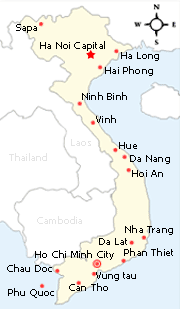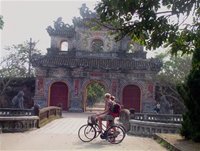|
Hue, a World Heritage site and one of the most popular destinations for visitors to Vietnam, is a mysterious, peaceful city with a unique cultural identity. It is, full of lakes, canals, lush vegetation and magnificent historical sights, including the early 19th century walled citadel, dozens of Buddhist temples and seven royal mausoleums.
Ancient and cryptic characters carved onto the tombs exhilarate tourists to step into the royal land. The first impression should be Ngo Mon Gate, which is fantastic and filled with secrets and stands imposingly in the green-moss-covered wall surrounded by a lotus canal. Tourists can spend the day strolling the royal land that covers over 500 hectares and is surrounded by Kinh Thanh (Imperial City), Hoang Thanh (Royal City) and Tu Cam Thanh (Forbidden City). Legend says that Hoang Thanh was originally built from clay, then from brick under King Gia Long. The height of the Nguyen Dynasty was reached during the reign of Emperor Minh Mang (1820-1840) and his tomb was built 12 kilometers from Hue between 1840 and 1843. It took ten thousand soldiers and artisans to complete the project. The tomb consists of about 40 monuments of various sizes; all lie within an oval shaped wall with a circumference of 2000 meters. Born in 1829, an expert in eastern philosophy, history and literature, Emperor Tu Duc had the longest reign of all the kings of the Nguyen Dynasty. The King died in 1883 after 35 years on the throne. Built between 1864 and 1867, his tomb includes 50 monuments and is surrounded by a 1,500 meter wall. Being a romantic, the king immersed himself in the world he created at the site of his tomb which was designed as a fairyland with poetical features, making it a lifetime dream and a world for his eternal life after death. Emperor Khai Dinh’s tomb is the smallest but it took 11 years to complete, from 1920 to 1931, and has many elements of Western architecture. In fact, of all the tombs, Khai Dinh’s probably least resembles oriental architecture with its slate roof and wrought iron gate. Beyond modern building materials and designs, the tomb has elements of eastern art mixed with western designs. In the interior of the tomb, colored glass and ceramic chips were used to form mosaics of oriental design. The ceilings were hand painted much like the ceilings of western churches, but the designs are of dragons and clouds. That is why people consider Emperor Khai Dinh’s tomb an example of Vietnamese ‘neo-classicism’. VietNamNet/SGT Other news for Tuesday 25 August, 2009 View all news for Tuesday 25 August, 2009 on one page News for Monday 24 August, 2009 View all news for Monday 24 August, 2009 on one page Recent News
|










